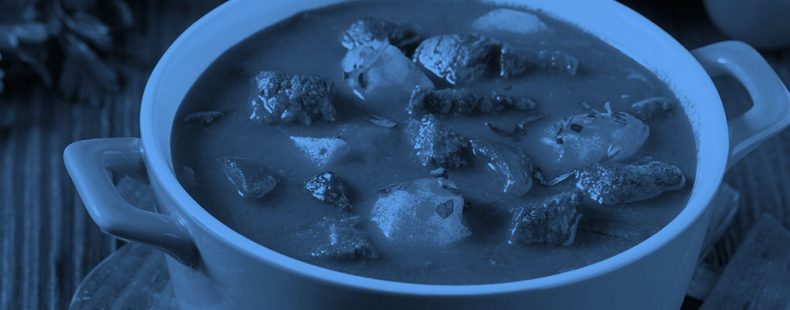Throw a bunch of ingredients in a pot, add liquid, heat it up, and what do you get? That’s actually a harder question to answer than you might think. Dishes made in this way can be labeled soup, stew, broth, bisque, or chowder.
When it comes to food, people have strong preferences not only about taste but also about what things are called. In this article, we’ll get to the bottom of the bowl by explaining when and why a dish may be called a soup vs. a stew and breaking down the same distinctions between soup and broth, bisque, and chowder.
⚡ Quick summary
Generally speaking, a dish is called soup when it’s primarily liquid-based. Stews are thicker and chunkier. But an especially thick and chunky soup could be called a stew. Broth is a liquid that serves as a main ingredient for many soups, and can be considered a soup when eaten by itself. Bisque and chowder are different types of soup.
What is the difference between soup vs. stew?
The main characteristic of the dish we call soup is that it’s primarily liquid-based. Regardless of what other ingredients it has in it (meat, fish, vegetables, whatever), they’re either submerged (or mostly submerged) in the liquid or are blended as part of it. The first example constitutes what’s often called a brothy soup. The second example is what we’d usually call a creamy soup (creamy as in texture—it may or may not have cream in it). But there are a lot of variations. And this is where the plot thickens.
The dish we call stew may start the same way as a soup, and can include many of the same ingredients used in soup (meat, fish, vegetables, whatever). Stews are cooked by simmering or slow boiling, known as stewing. Obviously, the descriptions of soup and stew sound very similar.
The popular distinction between these two foods is how “liquidy” or how thick they are: a dish called soup typically has more liquid in it than a stew does. Stews are generally thicker than soups, being made up primarily of larger, solid chunks of ingredients. In other words, stews are thicker and chunkier—and always have solid ingredients.
Generally speaking, if there is so much liquid that the ingredients are fully submerged, it’s a soup. If the chunks dominate the dish, it’s a stew.
What’s the difference between roasting and baking?
Of course, a dish labeled as soup can be pretty thick and chunky. And, sometimes, cooking adjustments can turn one into another. A soup could become a stew if cooked long enough that most of the liquid boils off or is absorbed by the ingredients. Or you could add more liquid to a stew to make it soupier. The point at which a soup becomes a stew (or vice versa) can be endlessly debated.
That’s because there is no exact measurement or technical rule separating the two. In many cases, both words could be reasonably applied to the same dish. The difference is often simply a matter of preference or opinion.
broth vs. soup
The essential ingredient in many soups is broth (or stock). Broth is traditionally made by boiling or simmering water with ingredients that will give it flavor, such as meat, fish, or vegetables (and often a combination of things).
The primary flavor of a broth is often specified: chicken broth, beef broth, vegetable broth, etc. For example, chicken noodle soup is traditionally made with chicken and noodles in a chicken broth.
But can broth be considered soup by itself? Yes, in fact, when broth is eaten—even without any added ingredients—it is typically considered soup. For example, a type of clear soup known as a consommé can be considered a broth if it is used as a base for the addition of other ingredients but a soup if it is eaten by itself.
bisque vs. soup
A bisque is a type of thick soup that uses cream as a main ingredient. The term bisque is typically applied to soups that have some kind of shellfish or vegetable as the key ingredient. Classic examples of bisques include lobster bisque, shrimp bisque, crab bisque, tomato bisque, and potato bisque.
While most people agree that bisque is a type of soup, some may distinguish creamy bisques from non-creamy soups in the same way that others distinguish liquid-forward soups from chunky stews.
Can too much soup put you into a food coma? Read more about the term here.
chowder vs. soup
Chowder is a type of thick soup whose most traditional and well-known forms contain clams, fish, or other seafood, often in a creamy, milk-based broth and also featuring potatoes, onions, tomatoes, or other vegetables. Different types of clam chowder are especially popular in the Northeast region of the US. Other examples of chowder include fish chowder, corn chowder, and potato chowder.
Most chowders are usually considered a type of soup, but their creamy thickness can also result in them being labeled as a stew.
Some people may take the hairsplitting even further and argue that chowder is its own unique thing in the same way that people distinguish soups from stews.














